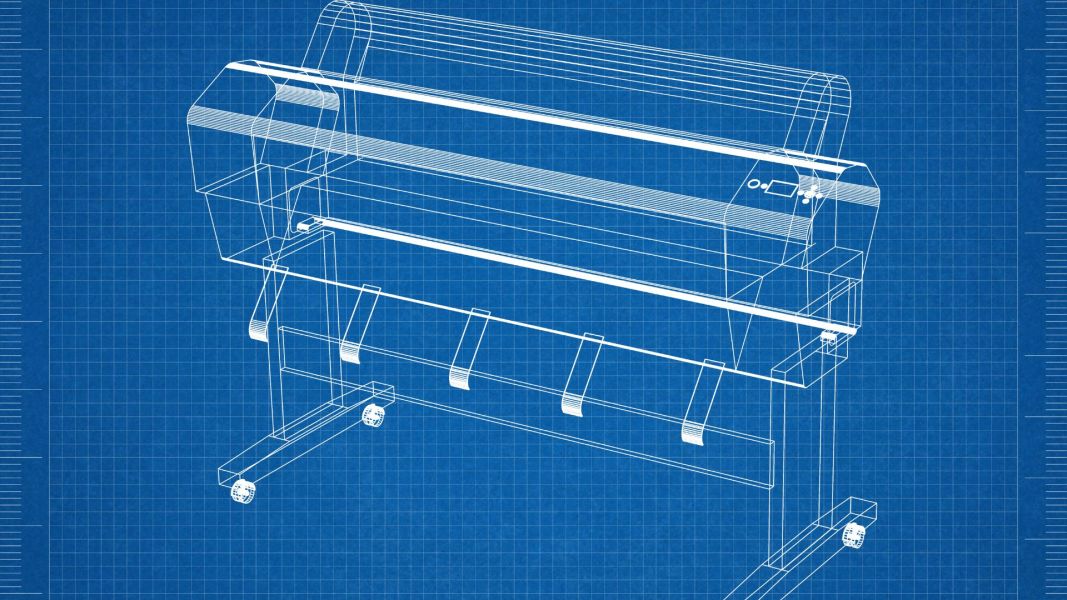When it comes to CAD and design work, choosing the right plotter is key to achieving high-quality, precise prints. Professionals in architecture, engineering, and graphic design rely on types of plotters that deliver accuracy, resolution, and durability. Each has unique benefits for different tasks, from inkjet and laser to multifunction and pen plotters. This guide will help you understand the best types of plotters for CAD and design projects so you can make an informed choice.

1. Inkjet Plotters: Rich Colour and Detail for Design Precision
Inkjet plotters are widely used in CAD and design work because they produce high-quality, detailed images with smooth colour transitions. These plotters spray tiny droplets of ink onto the media, offering excellent colour depth, which makes them ideal for projects with detailed visual requirements.
Why Inkjet Plotters Work for CAD and Design?
Inkjet plotters excel in colour detail and fine gradients, making them perfect for architectural renderings and complex designs. They are particularly useful for designers who need vibrant and accurate colour representation. However, they tend to be slower than other types, which can limit their effectiveness for high-volume projects.
2. Laser Plotters: Speed and Clarity for Monochrome Jobs
Laser plotters are highly effective for high-volume CAD work, particularly for monochrome documents. Using laser technology and toner, these plotters quickly produce sharp, clear images, making them a preferred choice in engineering and technical drawing.
Why Laser Plotters Suit CAD Work?
Laser plotters are ideal for technical prints that require precise line work, such as blueprints and schematics. Their efficiency and speed make them suitable for large quantities of monochrome output jobs. Although they don’t match inkjet plotters in colour detail, they are highly effective for projects where speed and accuracy matter.
3. Pen Plotters: Unmatched Precision for Technical Drawings
Pen plotters offer a unique advantage for technical drawings, blueprints, and line-based projects. They use mechanical pens to draw directly on the media, delivering exceptional accuracy in line work, which is invaluable in engineering and architecture.
Benefits of Pen Plotters for CAD and Design
Pen plotters’ precision makes them ideal for applications requiring exact line accuracy. They provide clear, defined lines, which is essential for CAD tasks that require every detail to be accurate. While slower than other plotter types, pen plotters remain a trusted choice for projects where line quality is paramount.
4. Thermal Plotters: Durable Prints for Outdoor Applications
Though less common in CAD, thermal plotters have unique advantages for projects requiring durable, weather-resistant prints. Using heat to transfer dye or wax-based ink, these plotters are ideal for signage and outdoor applications where print durability is essential.
Why Thermal Plotters Are Useful for CAD?
Thermal plotters produce long-lasting prints that resist sunlight and moisture, which is beneficial for industrial and construction-related CAD applications. Although they’re limited in colour options, their durability makes them suitable for outdoor projects where longevity is a priority.
5. Multifunction Plotters: Versatile Solutions in One Machine
Multifunction plotters combine various tasks—printing, scanning, and copying—into a single machine, making them valuable for firms with diverse document needs. While they may not offer the specialised quality of single-function plotters, multifunction plotters are highly practical for businesses needing flexibility.
How Multifunction Plotters Benefit Design Work?
For CAD firms that require versatility, multifunction plotters provide a balanced approach to various tasks. They handle large-format and standard-size prints, offering a mix of functions that save space and streamline workflows. Although they may compromise on quality for certain tasks, their multifunctional capabilities make them convenient for offices managing various document needs.
6. Cutting Plotters: Precision Cutting for Creative Projects
Cutting plotters differ from traditional plotters in that they cut shapes from vinyl, fabric, and cardstock rather than apply ink. These plotters are essential in the fashion and graphic design industries, where precise cuts are essential for creating custom designs and signage.
Advantages of Cutting Plotters in Design Work
For design tasks requiring exact shapes and patterns, cutting plotters provide precision invaluable in fields like product design and custom decor. They allow for intricate cuts without sacrificing quality, though they are limited to cutting rather than traditional printing. Cutting plotters are perfect for creating custom graphics and detailed shapes, adding creative flexibility to design work.
Selecting the Right Plotter for CAD and Design
Choosing a plotter for CAD and design depends on your needs, from colour detail to high-volume monochrome prints. Here’s a quick guide to help with your selection:
- For Colour Detail: Inkjet plotters are best for high-resolution, colour-rich designs.
- For Monochrome Precision: Laser plotters offer speed and sharp lines for high-volume monochrome printing.
- For Line-Based Detail: Pen plotters provide exact line work perfect for technical drawings.
- For Durability: Thermal plotters create long-lasting prints for outdoor CAD applications.
Selecting the right plotter for CAD and design work involves understanding the strengths and limitations of each type. With several types of plotters available, from inkjet and laser to pen and cutting plotters, choosing the one that fits your specific requirements will enhance your work quality and efficiency. Each plotter offers unique benefits, whether you need vibrant colours, precise lines, durable prints, or intricate cuts, ensuring your CAD and design projects meet professional standards.

Founder Dinis Guarda
IntelligentHQ Your New Business Network.
IntelligentHQ is a Business network and an expert source for finance, capital markets and intelligence for thousands of global business professionals, startups, and companies.
We exist at the point of intersection between technology, social media, finance and innovation.
IntelligentHQ leverages innovation and scale of social digital technology, analytics, news, and distribution to create an unparalleled, full digital medium and social business networks spectrum.
IntelligentHQ is working hard, to become a trusted, and indispensable source of business news and analytics, within financial services and its associated supply chains and ecosystems












